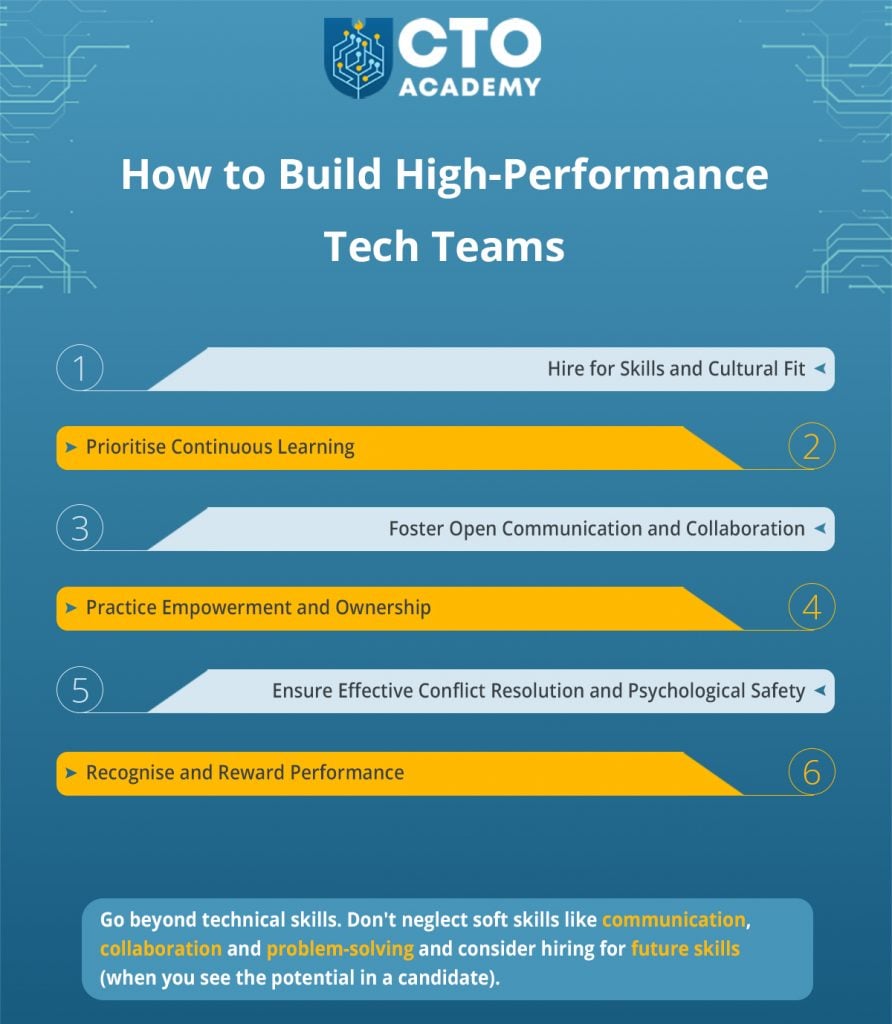The primary request for any senior tech leadership role is leading a strong team that consistently delivers groundbreaking innovations and achieves measurable results. That means you don’t merely manage a tech team; you must have the vision to lead it.
Strong leaders provide a compelling vision and roadmap, improving team focus and motivation. Combined with a culture of trust and open communication, it creates a high level of psychological safety for the team. In turn, such a team is more open to risk-taking, innovation and honest discussion of challenges.
Why is this important to your organisation and, more importantly, you?
Unlike other senior leadership roles, technology leadership is essentially about aligning tech with business goals. When technical initiatives are converged with broader business objectives, they drive innovation and bottom-line results. In other words, perfect alignment gives a company a competitive advantage and subsequent long-term growth.
The other reason why organisations require effective leadership is because it lowers risks, resolves conflicts and helps teams anticipate challenges, increasing the likelihood of delivering projects on time and within budget.
Finally, let’s not forget that talented tech professionals want to work for inspiring leaders in thriving environments (ie, attraction and retention of talent – check!).
Career advancement for a starter. As a rule of thumb, tech leaders command higher salaries due to greater responsibility. This translates into more influence within the organisation.
Also, moving from managing tasks to leading people and driving impactful projects creates a greater sense of purpose and achievement.
Effective tech leaders gain visibility and often interact with high-level stakeholders across the business, expanding their professional network.
However, it all begins with building high-performance tech teams because, at the end of the day, leaders are only as good as their teams.

High-performance tech teams are the key to unlocking innovation, achieving project goals and staying ahead of the curve. Here’s how to build one from scratch:
Building a high-performance tech team is an ongoing process, not a one-time event. That process includes continuous learning, open communication and empowerment. In time, you’ll create an environment where talented individuals can thrive.
Remember, a motivated and engaged team is the cornerstone of any successful tech venture. And such a team is your engine through an array of different roles.
(For a detailed insight into the roles and responsibilities of Chief Technology Officers in different business sizes, read this guide.)
As you can imagine, these roles require a unique blend of technical knowledge, business acumen, leadership skills and a commitment to ongoing learning.
Which brings us back to one of the key roles of tech leadership: setting technology strategy to align tech with the company’s mission and objectives.
While technical prowess is important in this process, several core leadership skills truly propel you forward.
Or, in other words, seeing the big picture, understanding long-term trends and aligning technology investments with the organisation’s overall mission and goals. This prevents short-sighted tech decisions that waste resources or don’t contribute to overall success.
Proper strategic thinking avoids reactive tech and ensures solutions serve an overarching purpose (eg, a CTO who aligns an AI initiative with improving customer service, not just for the sake of cutting-edge tech).
Since tech is full of unexpected roadblocks, as a tech leader, you must create structured approaches to identify root causes, generate creative solutions and make well-informed decisions.
A good example is a project manager who facilitates a root cause analysis instead of just blaming developers for a delay.
To be able to articulate often complex technical concepts in clear, accessible language for both technical and non-technical stakeholders, you’ll need to switch from just listening to active listening and adapt your communication styles.
Clear communication is essential for fostering collaboration, avoiding misunderstandings, inspiring teams and building trust in a leader’s vision.
Tech is made by people, and the best ideas arise with a strong team dynamic. For a tech leader, this means attracting top talent, creating an inclusive culture, fostering collaboration, resolving conflicts and motivating individuals to work towards a common goal.
Strong teams simply produce better results, are more resilient to challenges and are more likely to innovate.
Tech environments are rarely static. Leaders must often adjust plans, learn new skills and guide their teams through uncertain terrain. Because, at any moment, the company strategy can change (eg, a Black Swan event) and as a leader, you are expected to pivot these strategies while remaining agile.
Take a moment to answer these three questions:
Ethical decision-making builds trust with consumers and employees, avoids potential harm and positions the organisation as a responsible leader in the industry.
Of course, these are just the most prominent from the list of skills technology leaders must possess to do their jobs effectively. Our free tech leadership book, “90 Things You Need to Know to Become a CTO” expands on critical areas of tech leadership through 9 logical sections. It is a rich resource that will come extremely handy on your journey so take a moment and download it before you continue.
It’s simple and requires nothing but objective self-assessment.
STEP 1: Write down the core skills we explained and rank yourself (1-5) on each skill.
STEP 2: Objectively reflect on strengths and areas with the most growth potential.
STEP 3: Self-discussion
STEP 4: Challenge
To gauge and benchmark your current strengths and weaknesses against the hundreds of global tech leaders who’ve already completed the process, complete our Skills Assessment.
Natural talent is a start, but deliberate growth is key.
Common sense tells us that continuous development (personal and professional) is one of the key components of technological leadership in business.
But what are the most effective strategies considering our busy daily schedules? We can’t exactly commit to traditional university programs, can we? So what’s the optimal approach to this problem?
Before we lay down the strategies, think about this: we cannot improve what we do not acknowledge.
Let that soak for a moment…
These skills compound – it’s about the interplay between them that leads to exceptional leadership outcomes.
The analogy is a well-tuned orchestra. Each instrument, no matter how good it sounds on its own, is nowhere near as effective as when it plays its part at just the right moment with the rest of the orchestra. When perfectly combined, the outcome is pure excellence.
However, it is, essentially, a conductor that transforms this collection of instruments into a well-tuned orchestra. That’s why you need someone with experience by your side, especially at the beginning of your CTO career. We are talking about structured programs, Q&As with field experts and CTO shadowing.
While self-directed learning is valuable, a comprehensive program provides a focused framework, expert guidance and a supportive community.
“One of the best parts was getting to meet and talk with other people in the course. Whether it was networking sessions or just group discussions, it was comforting to see that others face similar challenges. Sharing ideas and experiences with a diverse group really broadened my perspective and was incredibly valuable.”
Dallas Goldswain
The path Dallas and over 440 tech leaders have taken so far leads you through all 9 areas of your future career:
The outcome here is gaining the tools to a) lead with confidence, b) make optimal strategic tech decisions and c) inspire your teams to achieve their best. And if you briefly check here, you’ll quickly realise the promise is delivered.
This was a quick introduction to tech leadership where we covered the fundamentals – the what and the why. What comes next is exciting, empowering and, most importantly, educating because it explains the how of everything. You will get the necessary knowledge and tools to put your leadership skills into action.
90 Things You Need To Know To Become an Effective CTO

London
2nd Floor, 20 St Thomas St, SE1 9RS
Copyright © 2024 - CTO Academy Ltd